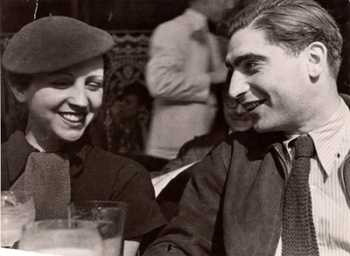Republican Spain: Images of tragedy and compassion
This year marks the 97th anniversary of the death of Gerda Pohorylle. As a young idealistic socialist she quit her German homeland and made for France, arriving in its capital during 1934. Here she changed her name to Gerda Taro. She was responsible for moulding a young bohemian photographer into arguably the greatest photojournalist in the history of news gathering.
By John MacDonald
Robert Capa, real name Endre Friedmann was himself a refugee from Admiral Horthy's Hungary, met Taro in Paris in the autumn of 1934. Their mutual attraction was immediate, they became lovers, colleagues and conspirators.

Gerda Taro - photo http://www.combatcamera.be/
Taro set to work on Friedmann's appearance. She persuaded him to forsake his tattered leather jacket for a suit, shirt and tie. This gave him a semblance of respectability by concealing his most obvious gypsy features. Once the transformation was complete she sent him back onto the streets camera in hand.
To complete the illusion and to hype the cost of Friedmann's pictures the pair invented the persona of Robert Capa. An imaginary American photographer attributed to be rich and successful.
The device worked well with Friedmann scouring Paris for saleable images and Taro touting the photographs around editorial offices at inflated prices. The ruse was inevitably discovered and Friedmann had no option but to adopt the guise of Robert Capa.
The legend had a momentum all of its own, afloat on a sea of humorous anecdotes, courage and evocative photography. Capa caught the essence of conflict. Not the blood and guts images that only serve to shock but the facial expression of nations at war. The shapes and tones of the suffering expressed by those who suffer most, civilians and foot soldiers.
In 1936 Taro and Capa went to cover the Spanish Civil War. Taro was by now a photojournalist in her own right and was looking forward to having her pictures published under her own by-line. They were both vehemently anti-fascists and
determined to use their journalistic skills in the cause of the Spanish Republic.
In late August 1936 the couple arrived at the front to the north of Córdoba. There was a lull in the fighting and in desperation Capa staged several photographs. He was desperate to provide images of Republican successes, but these photographs lacked conviction and fooled no one. However, the one he took at Cerro Muriano did. This was the famous Fallen Soldier photograph as it became known. Debate over the image's authenticity has continued since its first publication.
On the 5th of September Capa photographed a CNT militiaman falling as if dropped by a bullet. The photograph caused a sensation when first published and controversy ever since. Doubts exists. Were Capa and Taro even at Cerro Muriano on that date? The pro-camp has offered up one Federico Borrell García as the dying militiaman.
Some of the photographs from the sequence are staged. Another frame shows a different militiaman falling in the same spot as the Fallen Soldier. Coincidence? Capa used an early Leica probably a III or IIIa. A very portable camera but requiring an external exposure meter. If one was staging a photograph with such a camera it would seem logical to adjust aperture and shutter speed for a particular light. Then bring on the actors.
It was not only Capa's photographs that attracted comment. His personal life also came in for scrutiny. As a house guest, one visit from Capa usually sufficed. He would borrow money, cigarettes, booze and if he could get away with it, your wife. While running the Magnum office in Paris, he was not adverse to spending the wages of the correspondents on assignment.
He lived in hotels drinking and gambling into the early hours, if he needed female company he was quite willing to pay for it. A lot of his tales were questionable to say the least. His cure for a hangover was to spend hours in the bath, anyone's bath.
This however was the nature of the man. He was also very generous. If he had money, everyone ate and drank until the cash was exhausted. He spent hours with the young recruits to the Magnum agency teaching them their trade. His most endearing quality was his compassion.
This compassion was obvious in his interaction with others, manifesting itself in his captured images.
Can we forget the flaws in his character?
We do not know all the events which shaped his life. Nor should we. They have absolutely nothing to do with us. We do know that Capa never forgave himself for being in Paris when Taro died. Crushed by a tank during the Republican retreat from Brunete, she didn't even reach her 26th birthday.
Capa left his photographs to the world. Can we judge him by those alone?
At the Museo Nacional Centro de Arte Reina Sofía Capa's Spanish Civil War photographs are archived. In these images we see intensity like no other. We see pride, fear and hopelessness on the faces of those men and women at Montblanch as they watch the International Brigades leave Spain. We walk the bomb cratered road of misery from Málaga to Almería. Share the horror of the civilian retreat from Cerro Muriano.
In those black-and-white images we see a mother and daughter in Bilbao running for cover during an air-raid their frightened faces upturned. Their coats hastily fastened.
They live again for us. You can walk among the ruins of Madrid, the Crucified City, or share the laughter of the militiamen and women as they relax in Barcelona.
From Bilbao to Almería, Capa captured the emotions of the nation. Not the great events or the mighty statesmen but those who really matter, the ordinary people.
